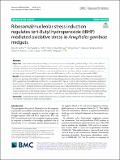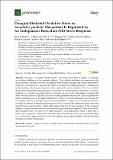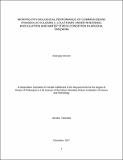Ribosomal/nucleolar stress induction regulates tert-Butyl hydroperoxide (tBHP) mediated oxidative stress in Anopheles gambiae midguts.
| dc.contributor.author | Tarimo, Brian | |
| dc.contributor.author | Hritzo, Bernadette | |
| dc.contributor.author | Law, Henry | |
| dc.contributor.author | Tao, Dingyin | |
| dc.contributor.author | Pastrana-Mena, Rebecca | |
| dc.contributor.author | Kanzok, Stefan | |
| dc.contributor.author | Buza, Joram | |
| dc.contributor.author | Dinglasan, Rhoel | |
| dc.date.accessioned | 2019-07-30T11:07:36Z | |
| dc.date.available | 2019-07-30T11:07:36Z | |
| dc.date.issued | 2019-03-29 | |
| dc.identifier.issn | 1756-0500 | |
| dc.identifier.other | 30922378 | |
| dc.identifier.uri | https://doi.org/10.1186/s13104-019-4196-1 | |
| dc.identifier.uri | http://dspace.nm-aist.ac.tz/handle/123456789/391 | |
| dc.description | Research Article published by BMC Research Notes | en_US |
| dc.description.abstract | Objective: A fundamental understanding of redox homeostasis in Anopheles gambiae midgut cells under different oxidative conditions is missing. Such knowledge can aid in the development of new malaria transmission-blocking strategies aimed at disrupting natural homeostatic processes in the mosquito during Plasmodium parasite uptake (i.e. blood feeding). The aim of this study was to understand how the An. gambiae midgut regulates oxidative stress to reactive oxygen species (ROS), especially to a potent ROS-inducer such as tert-Butyl hydroperoxide (tBHP). Results: Initial studies using quantitative immunoblot indicated that the expression of the classical antioxidant protein An. gambiae thioredoxin-1 (AgTrx-1) remained unchanged across challenges with different concentrations of tBHP suggesting that additional mechanisms to regulate ROS may be involved. We therefore conducted a global proteomic survey, which revealed that An. gambiae midguts under low (50 μM) and high (200 μM) tBHP concentrations were enriched in proteins indicative of ribosomal/nucleolar stress. Ribosomal stress is an inherent cellular response to an imbalance in ribosomal proteins (RPs) due to cellular stress such as oxidative stress. Our data suggest that ribosomal/ nucleolar stress is the primary cellular response in An. gambiae midguts under tBHP challenge. Considering these results, we discuss harnessing the ribosomal stress response as a potential malaria transmission-blocking strategy. | en_US |
| dc.language.iso | en | en_US |
| dc.publisher | BMC Research Notes | en_US |
| dc.subject | Anopheles gambiae | en_US |
| dc.subject | Malaria | en_US |
| dc.subject | Nucleolar stress | en_US |
| dc.subject | Oxidative stress | en_US |
| dc.subject | Plasmodium | en_US |
| dc.subject | Ribosomal stress | en_US |
| dc.subject | Thioredoxin | en_US |
| dc.subject | Transmission-blocking | en_US |
| dc.subject | tert-Butyl hydroperoxide | en_US |
| dc.title | Ribosomal/nucleolar stress induction regulates tert-Butyl hydroperoxide (tBHP) mediated oxidative stress in Anopheles gambiae midguts. | en_US |
| dc.type | Article | en_US |




